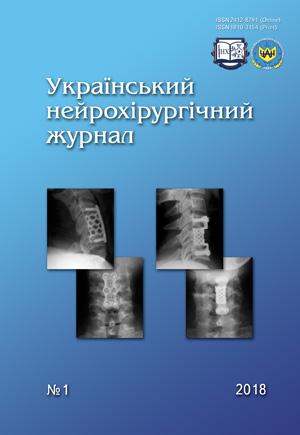Comparison of clinical outcomes of open and minimally invasive decompression and stabilization at stenosis of the lumbar spine
DOI:
https://doi.org/10.25305/unj.90415Keywords:
lumbar stenosis, decompression, stabilizationAbstract
Objective. To compare the results of open and minimally invasive surgical procedures for the decompression and stabilization of the lumbar spine stenosis.
Materials and methods. We operated 171 patients with instable stenosis of the lumbar spine, using instrumentation. One hundred and thirty-six surgical interventions (OPEN group) were performed using traditional open method with midline incision, detachment of paravertebral muscles from bone structures. In 35 patients (the MAST group), we performed minimally invasive decompression using Medtronic METRx and QUADRANT systems. There were estimated the pain syndrome intensity with NPS, quality of life with OSWESTRY, surgery duration, blood loss, time of staying in hospital, and X-ray loading during operation.
Results. Surgery duration was slightly higher than that of the classical operation – 174±79 and 158±77 min in MAST and OPEN, respectively. Blood loss in MAST and OPEN groups was 150±60 and 680±130 ml, respectively. X-ray control during the operation in MAST and OPEN groups was 46 and 21, respectively. NPS before operation in MAST and OPEN groups was 7.7, 7.95, respectively. The week after operation in MAST group was 3.0, in OPEN group was 3.6, 6 months MAST and OPEN groups was 1.67, 2.13, respectively; at the time of interview MAST – 1.75, OPEN – 2.08. Before surgery, OSWESTRY was 62% in both groups. In 7 days in MAST and OPEN groups it was 28%, 32%, respectively; in 6 months it was 19.3% and 19.2%in MAST and OPEN groups, respectively, and at the time of interview in MAST group it was 17.6%, in OPEN – 17.6%. The average stay in the hospital is 9.00±2.81 and 12.5±2.35 days.
Conclusion. The results show effectiveness of both surgical techniques used. The MAST group is characterized with lower invasiveness and lower blood loss whereas more intensive X-ray irradiation and longer duration of the operation. Activation of patients is more comfortable in the MAST group.
References
1. Shevelev IN, Goushcha AO, Konovalov NA, Arestov SO. Destandau Endoscopic Discectomy in Patients with Lumbar Intervertebral Disc Hernia. Hirurgiв pozvonočnika. 2008;(1):51-57. [eLIBRARY.RU]
2. Hegde D, Mehra S, Babu S, Ballal A. A Study to Assess the Functional Outcome of Decompression and Posterior Lumbar Interbody Fusion of Low Grade Spondylolisthesis of Lumbar Vertebra. J Clin Diagn Res. 2017 Mar;11(3):RC01-RC03. [CrossRef] [PubMed] [PubMed Central]
3. Lee KH, Yue WM, Yeo W, Soeharno H, Tan SB. Clinical and radiological outcomes of open versus minimally invasive transforaminal lumbar interbody fusion. EurSpine J. 2012 Nov;21(11):2265-70. [CrossRef] [PubMed] [PubMed Central]
4. Seo JS, Lee SH, Keum HJ, Eun SS. Three cases of L4-5 Baastrup’s disease due to L5-S1 spondylolytic spondylolisthesis. Eur Spine J. 2017 May;26(Suppl 1):186-191.[CrossRef] [PubMed]
5. Park Y, Ha JW, Lee YT, Oh HC, Yoo JH, Kim HB. Surgical outcomes of minimally invasive transforaminal lumbar interbody fusion for the treatment of spondylolisthesis and degenerative segmental instability. Asian Spine J. 2011 Dec;5(4):228-36. [CrossRef] [PubMed] [PubMed Central]
6. Yeoh D, Moffatt T, Karmani S. Good outcomes of percutaneous fixation of spinal fractures in ankylosing spinal disorders. Injury. 2016 Oct;45(10):1534-8. [CrossRef] [PubMed]
7. Foley KT, Holly LT, Schwender JD. Minimally invasive lumbar fusion. Spine (Phila Pa 1976). 2003 Aug 1;28(15 Suppl):S26-35. [PubMed]
8. Fessler RG, Sekhar LN. Atlas of neurosurgical techniques: spine and peripheral nerves. New York: Thieme; 2016.
9. Seng C, Siddiqui MA, Wong KP, Zhang K, Yeo W, Tan SB, Yue WM. Five-year outcomes of minimally invasive versus open transforaminal lumbar interbody fusion: a matched-pair comparison study. Spine (Phila Pa 1976). 2013 Nov 1;38(23):2049-55. [CrossRef] [PubMed]
10. Park P, Foley KT. Minimally invasive transforaminal lumbar interbody fusion with reduction of spondylolisthesis: technique and outcomes after a minimum of 2 years’ follow-up. Neurosurg Focus. 2008;25(2):E16. [CrossRef] [PubMed]
Downloads
Published
How to Cite
Issue
Section
License
Copyright (c) 2018 Kostyantyn I. Gorbatyuk, Valeriy М. Olkhov, Volodymyr V. Kirichenko, Dmytro S. Maystruk, Oleksandr S. Lemeshov

This work is licensed under a Creative Commons Attribution 4.0 International License.
Ukrainian Neurosurgical Journal abides by the CREATIVE COMMONS copyright rights and permissions for open access journals.
Authors, who are published in this Journal, agree to the following conditions:
1. The authors reserve the right to authorship of the work and pass the first publication right of this work to the Journal under the terms of Creative Commons Attribution License, which allows others to freely distribute the published research with the obligatory reference to the authors of the original work and the first publication of the work in this Journal.
2. The authors have the right to conclude separate supplement agreements that relate to non-exclusive work distribution in the form of which it has been published by the Journal (for example, to upload the work to the online storage of the Journal or publish it as part of a monograph), provided that the reference to the first publication of the work in this Journal is included.









